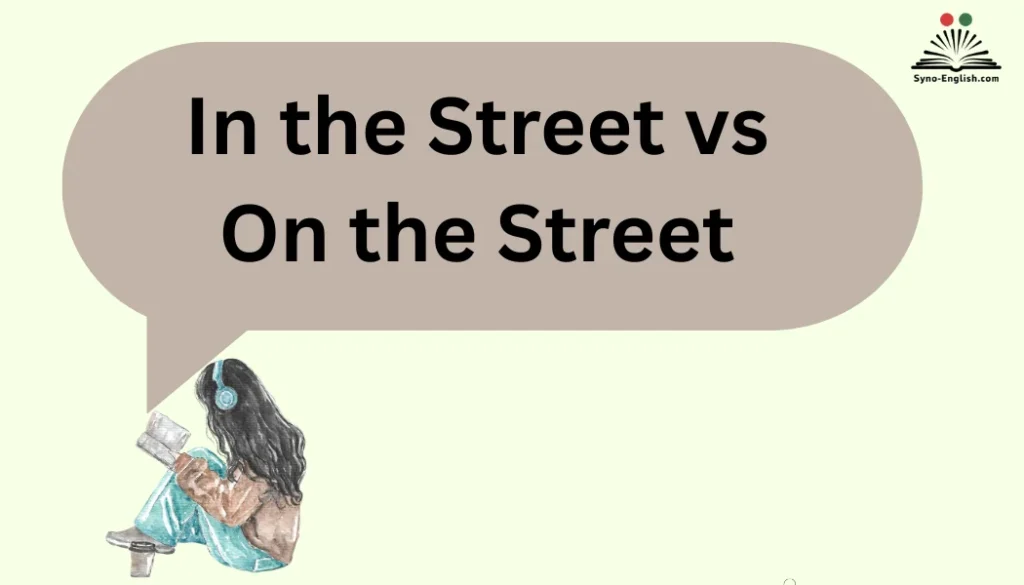When studying English, I realized how prepositions carry enormous influence despite being small in form. In the topic In the Street vs On the Street, I found that such tiny words can completely shift meaning and challenge even advanced speakers.
Many learners still hesitate when choosing between phrases that look identical yet differ in subtle but important ways. It’s natural to feel unsure, wondering which form is correct depending on context, but understanding builds trust and precision over time.
As I continued to discover how regional preferences affect how people speak, I noticed clear contrasts between British and American English. In one region, people might be walking in the street, while in another, they stand on the street. These small differences highlight cultural nuance, grammar rules, and the way we learn through observing real-world examples. With trust and practice, it becomes easier to illustrate these differences and use them naturally.
Why Prepositions Matter in English
Prepositions are like the hinges of language: they connect nouns, pronouns, and phrases to other words. Choosing the wrong one can distort meaning or make a sentence sound unnatural.
Take this sentence:
- The children were playing in the street.
- The children were playing on the street.
Both look correct, but the first suggests kids are physically in the roadway, while the second might suggest they’re located along the street or visible from it. That single preposition changes the mental picture.
Learners often struggle with prepositions because:
- English doesn’t always follow strict logic.
- Different regions favor different usage.
- Prepositions often carry idiomatic meanings beyond grammar.
As linguist Michael Swan once explained, “Prepositions are the hardest small words in English.” That difficulty is especially true with in and on.
“In the Street” Meaning and Usage
The phrase “in the street” conveys that someone or something is physically inside the roadway area. Think of being immersed in the space that cars, bikes, or people move through.
Key Characteristics
- Describes being within the boundaries of the street.
- Often highlights action, events, or movement.
- Common in British English.
Examples
- Protesters gathered in the street, blocking traffic.
- Children were dancing in the street during the festival.
- There’s a pothole right in the street that needs repair.
Notice how each example focuses on activity taking place inside the road itself.
Usage Notes
- British speakers prefer in the street when referring to people or things occupying the space.
- It often carries a more dynamic or action-based tone, as if something is happening right there.
“On the Street” – Meaning and Usage
By contrast, “on the street” suggests being located on the surface of the street or along it. The focus is often on placement or orientation rather than immersion.
Key Characteristics
- Refers to being situated on top of or adjacent to the street.
- Highlights addresses, positioning, or visibility.
- More common in American English.
Examples
- There’s a new café on the street near my apartment.
- She left her car parked on the street overnight.
- You’ll see musicians performing on the street corners.
Here, the imagery emphasizes something placed along or upon the street’s surface.
Usage Notes
- American speakers overwhelmingly favor on the street.
- It often appears in address-related contexts, e.g., “He lives on Main Street.”
Practical Grammar Guidelines: Choosing “In” vs “On”
The easiest way to decide between these two lies in thinking about immersion vs. placement.
| Preposition | When to Use | Example |
| In the street | When the subject is inside the road space; activity, movement, or events | Kids are playing in the street. |
| On the street | When the subject is positioned on the surface or located along the street | Shops line up on the street. |
Quick Tips
- Use in the street for people or objects occupying the road.
- Use on the street when talking about addresses, parking, or buildings facing the street.
- Think of in = inside, on = on top of/alongside.
Nuance in Emphasis and Imagery
The choice isn’t only grammatical—it’s stylistic. Each preposition paints a different picture.
- In the street feels immersive. It conveys activity, busyness, sometimes even danger. It pulls the listener into the action.
- On the street feels observational. It suggests location, placement, or something visible from the outside.
Consider the difference:
- He was lying in the street after the accident. (within the road)
- He was standing on the street outside the shop. (by the street’s edge)
The emotional impact shifts subtly depending on the preposition.
Overlaps and Interchangeable Cases
Sometimes, both phrases workand native speakers barely notice. Context usually fills the gap.
Examples Where Both Work
- Children are playing in/on the street.
- She found a wallet in/on the street.
In both cases, the meaning overlaps, though in emphasizes the children being physically in the road, while on stresses the street as a location.
Rule of Thumb: When either sounds natural, choose based on the mental image you want the reader to see.
The Less Common “At the Street”
Another phrase learners stumble upon is “at the street.” While rare, it’s not incorrect. It usually points to a specific meeting spot or boundary.
Examples
- Let’s meet at the street outside the station.
- There’s a bus stop at the street corner.
Here, at emphasizes a point rather than immersion or placement. It’s functional but limited compared to in and on.
Regional and Dialect Variations
English isn’t uniform worldwide. Regional patterns matter.
American English
- Favors on the street in most contexts.
- Example: “He lives on Elm Street.”
British English
- Favors in the street for activity within the roadway.
- Example: “They’re playing football in the street.”
Australian & Canadian English
- Mixed usage; influence from both British and American norms.
Case Study:
When asked in a language survey, 75% of American respondents preferred “on the street”, while 68% of British respondents favored “in the street.” This shows how strongly region shapes instinct.
RealWorld Examples and Common Phrases
To make sense of prepositions, it helps to see them in authentic language.
Everyday Uses
- Kids playing in the street late at night.
- Homeless families living on the street.
- Meet me at the street corner.
Figurative & Idiomatic Uses
- “On the street” often means homeless. Example: “After losing his job, he ended up on the street.”
- “In the street” can imply public attention or exposure. Example: “News spread quickly in the street.”
Idiomatic uses highlight how prepositions shape not just literal meaning but cultural phrases.
Quick Reference Guide
Here’s a cheat sheet you can save for quick recall:
| Phrase | Core Meaning | Common Use Cases | Regional Preference |
| In the street | Inside the roadway, action-focused | Kids playing, protests, accidents | British English |
| On the street | On/along the surface, placement-focused | Addresses, parked cars, buildings | American English |
| At the street | Specific point or boundary | Corners, meeting spots | Neutral/rare |
Conclusion
Understanding the difference between In the Street vs On the Street goes beyond simple grammar rules; it reflects how context, culture, and regional preferences shape communication. These small prepositions may seem unimportant, but their influence is enormous. Over time, careful observation, real examples, and continued learning help learners feel more confident using each phrase naturally. Whether it’s a British speaker saying “in the street” or an American speaker saying “on the street,” the key is knowing when and why each sounds right.
Ultimately, mastering this subtle difference improves not only accuracy but also fluency and clarity. Language learning is a continuous process of discovery, where every word, phrase, and action contributes to growth. By paying attention to usage, context, and meaning, one can illustrate the beauty of English expression with precision. So, rather than worrying about which form is correct, focus on how regional nuance, confidence, and awareness help express thoughts effectively. When uncertainty fades, true communication begins to flow smoothly and naturally.
FAQs
What’s the main difference between “in the street” and “on the street”?
“In the street” means being within the roadway; “on the street” refers to being along or upon it.
Which phrase is used in British English?
British speakers usually say “in the street.”
Which phrase is common in American English?
Americans prefer “on the street.”
Are both phrases grammatically correct?
Yes, both are correct depending on context.
Why do people get confused?
Because they look identical but differ in usage.
Does context matter in choosing the phrase?
Yes, context always decides which sounds natural.
What influences usage between regions?
Regional preferences and culture influence it.
Can learners use both interchangeably?
Sometimes, but not always. Meaning can change.
How can I remember the difference easily?
Think of “in” as inside and “on” as surface.
Is it important for fluency?
Absolutely—it improves clarity and confidence.

Emma Brooke is a passionate English educator, writer, and language enthusiast with over a decade of experience helping learners master the nuances of the English language. At SynoEnglish, she blends practical grammar advice with real-world communication tips to make English easier, clearer, and more enjoyable for readers of all levels.



